CRAB RANGOON TO RIVAL ANY RESTAURANT!
This Crab Rangoon recipe will be everyone’s favorite appetizer for your takeout fakeout nights, holiday parties, game day parties and everything in between! These homemade crab rangoon taste straight out of a restaurant – or dare I say even better?! They are tantalizingly crunchy on the outside giving way to warm, melty creamy crab filling inside. I’ve included step by step photos, easy to follow instructions for deep fried, baked and air fried crab rangoon, and how to freeze for an easy snack or appetizer any night of the week!
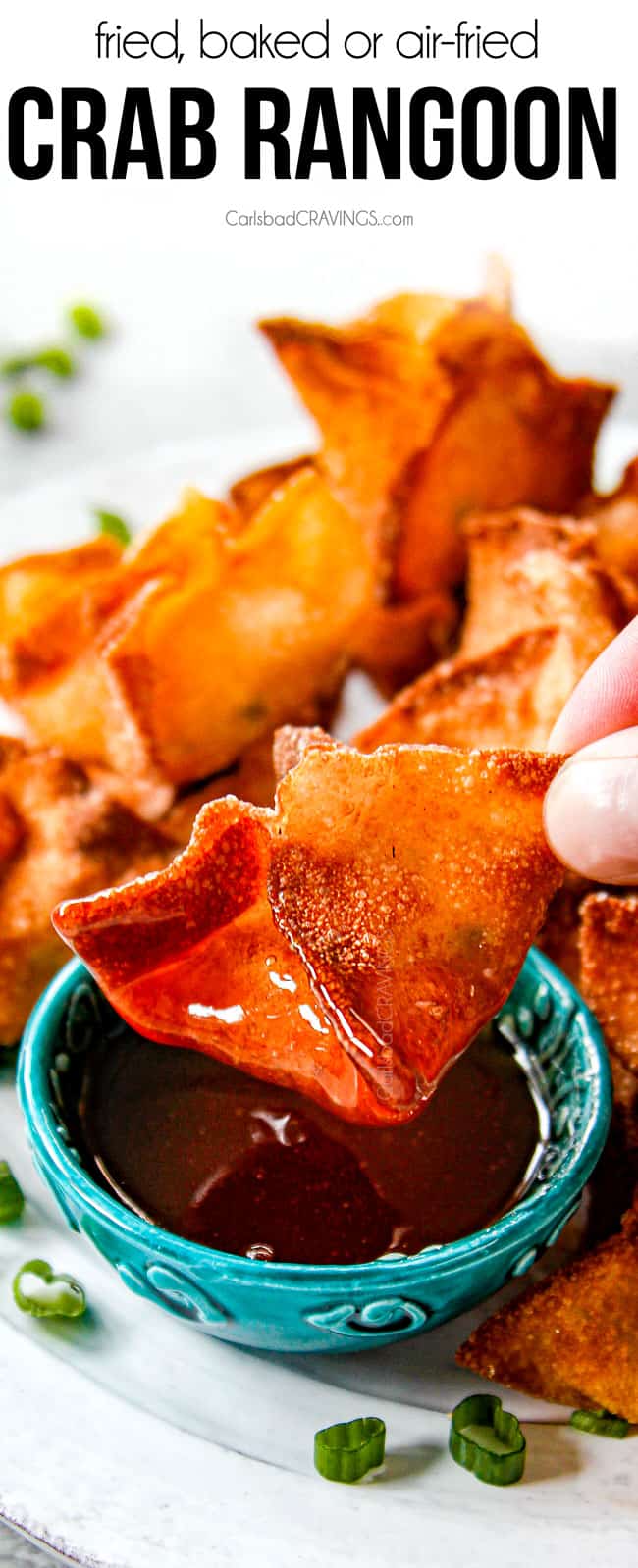
PIN THIS RECIPE TO SAVE FOR LATER

You will love this Crab Rangoon Recipe!
Whenever I frequent our favorite local Chinese restaurant, crab rangoon is always a must-order appetizer. The contrast between the shatteringly crispy fried exterior and the rich, creamy crab filling is mesmerizing. But as jaw-dropping delicious as crab rangoon are – did you know they are actually super easy to make at home? AND I think you’ll find this crab rangoon recipe tastes even better than takeout! With just some wonton wrappers, crab meat and pantry ingredients, you’re on your way to making the most talked about party menu appetizer!

What is Crab Rangoon?
Crab rangoon also known as crab puffs, crab cheese wontons, or crab pillows are a popular Chinese-American appetizer found at your favorite Chinese and Thai restaurants. Think of your favorite crunchy cream cheese wontons – then add delectable crab meat – and you have crab rangoon! They are a deep-fried dumpling made with a wonton wrapper stuffed with a combination of crab meat, cream cheese, green onions, garlic and other seasonings.
THE FILLING. I’ve devoured my share of crab rangoon over the years and have discovered not all fillings are created equal. Some are absolutely dreamy, while others are too runny, too bland, or too sweet. In my crab rangoon recipe, I’ve come up with what I think is the perfect balance of irresistibly creamy and flavorful – no bland or runny filling here!
My homemade crab rangoon filling is a simple blend of crab (fresh, imitation or canned), cream cheese, mayonnaise, green onions, and splashes of soy sauce, Worcestershire sauce, Asian chili sauce, toasted sesame oil, lemon juice and a few seasonings. The simple, pantry friendly ingredients (you can even use canned crab meat for extra ease) with a few extra ingredients than most, combine to create exponentially delicious results – and all you do is stir them together!
THE FOLDING. The scrumptious filling gets loaded into wontons which you can either seal up in an easy triangle or lock the filling in using my easy pouch technique. The folding and sealing might sound intimidating, but I’ve included step-by step photos and tips and tricks to ensure your success.
THE COOKING. The crab wontons are then fried, air-fried or baked OR you can freeze them for make ahead use. I personally prefer fried crab rangoon for the most crackling, crunchy exterior (it’s all about crunchy vs. creamy) but you can certainly air fry them or bake them as well – but you’ll have to adjust your crunchy expectations.
THE FREEZING. I also love that this crab rangoon recipe can be assembled and frozen for future use because this makes entertaining a breeze. A few minutes before your guest arrive, just fry or bake up the wontons and everyone gets to enjoy tantalizingly hot and crispy crab rangoon.
THE SERVING. Serve the golden crackling crab wontons with my favorite sweet and sour sauce for the ultimate culinary experience and listen to everyone sing your praises!
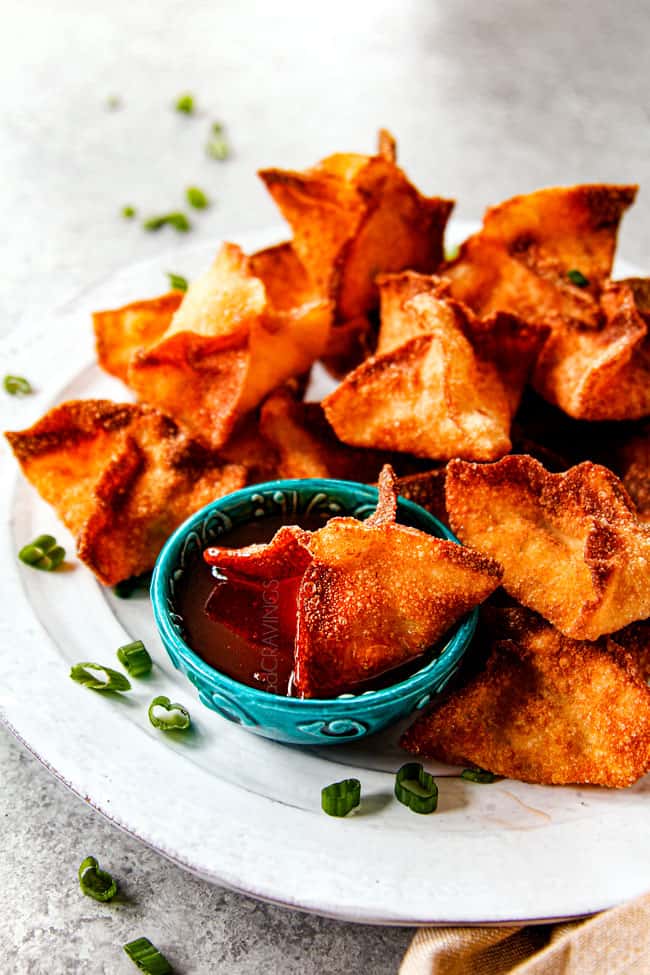
Crab Rangoon Ingredients
Homemade crab rangoon are super simple. They consist of wonton wrappers stuffed with a mixture of crab meat, cream cheese, green onions, Worcestershire sauce and seasonings. Here is what you’ll need:
- Wonton wrappers: you should be able to purchase wonton wrappers at any grocery store. If you want even crispier results, purchase them at an Asian market as authentic wonton wrappers are thinner and therefore emerge even crispier.
- Cornstarch slurry: to seal the wrappers, you will need 2 teaspoons cornstarch mixed with water. This “glues” the wrappers closed much more effectively than just water or an egg wash.
- Crab: you can use any crab meat here – what’s ever easiest/ most economical for you; even imitation crab will work.
- Cream cheese: make sure your cream cheese is soft enough so it easily mixes. You can microwave it at 15 second intervals until soft.
- Mayonnaise: just a few tablespoons make the filling extra creamy. Please use real mayo and not miracle whip.
- Green onions: I don’t recommend substituting with white/yellow onions or shallots because they will not soften like green onions in the crab rangoons and therefore will be too strong and crunchy.
- Soy sauce: grounds the filling and cuts through the creaminess. Use reduced sodium so we can control the salt.
- Worcestershire sauce: adds a depth of complex savory, slightly tangy flavor.
- Asian chili sauce: use your favorite chili sauce like Sambal Oelek or sriracha. Use as much or as little as you like. As written, the crab rangoon recipe uses 1 teaspoon chili sauce. This will NOT make them spicy but will add flavor. If you know you love heat, you might want to consider adding more – or you can add it to the sweet and sour sauce.
- Sesame oil: a “secret ingredient” that adds an irresistible, subtle nutty flavor.
- Lemon juice: you need just ½ teaspoon to brighten the filling so bottled is just fine.
- Sugar: balances the soy and Worcestershire.
- Seasonings: garlic powder, dried mustard, salt and pepper round out the flavor profile. I don’t recommend substituting with fresh garlic as it doesn’t distribute as well and will not flavor the entre filling evenly.


What Type of Crab Meat Should I Use for Homemade Crab Rangoon?
You have three options for crab meat in your crab rangoon recipe: canned crab, fresh crab or imitation crab. Here is the breakdown:
CANNED CRAB: This homemade crab rangoon recipe combines crabmeat with the cream cheese for a creamy filling, so I don’t think there’s a need to splurge on fresh crab. I personally prefer using canned crab because it is more economical, easy to use because it’s already been picked through, easy to keep in the pantry and the flavor and texture are ideal for the filling. When purchasing canned crab meat, you will need one 6 oz. can white lump crab meat, which comes from the knuckles of the crab and is the highest grade of canned crab meat. You may also use fancy white crab meat, which contains the white body meat, but it is considered one step down.
FRESH CRAB: If still want to use fresh crab meat, be my guest! If you are in the Mid-Atlantic States, look for blue crab, whose native habitat includes the Chesapeake Bay and is generally considered to be the best tasting and favorite choice. You can likely purchase crab meat at the seafood counter of your grocery store or specialty seafood markets or specially stores such as Whole Foods. Be sure to thoroughly pick over your crab meat for cartilage. Nothing will ruin a creamy bite of crab rangoon than biting into cartilage!
IMITATION CRAB: Many Chinese-American restaurants use imitation crabmeat in their crab rangoon because it is economical, but I urge you to use canned or fresh unless someone in your family is allergic to crab, even then you’ll still want to check imitation crab ingredients for crab extract. Imitation crab is made from minced fish flesh, often pollock, that has been deboned then combined with other ingredients, heated and formed into crab-like cuts. Although imitation crab is a fine tasting alternative, it contains sugar, starch and egg whites, preservatives and often MSG.

WHERE DO I FIND WONTON WRAPPERS?
You can’t make crab wontons without wonton wrappers, but you’re in luck, wonton wrappers are easy to find at any grocery store, and definitely at specialty Asian markets. At my grocery store(s), the wonton wrappers are located near the produce, at the end of the aisle in the refrigerated section. You will need 36 wonton wrappers for this crab rangoon recipe, so make sure you check the wrapper count. Depending on the brand of wontons wrappers you purchase, you may need one or two packages.

CAN I USE FAT FREE CREAM CHEESE?
Yes! You can make homemade crab rangoon with full-fat cream cheese or low-fat cream cheese. Full fat cream cheese obviously has more flavor and melts better, but rangoons made with low-fat cream cheese will still be tasty.

How to make Crab Rangoon
You will love how easy it is to make homemade crab rangoon! I will outline the steps below then go into further detail so you are guaranteed success! To make crab rangoon:
1. Mix up the filling ingredients.
2. Add the filling to the center of the wonton wrapper.
3. Brush the edges with cornstarch slurry, fold into a triangle or fold four corners together and press the edges together.
4. Fry rangoons or spray with oil and bake.
How easy is that?! I love that there is no cooking meat or chopping veggies (other than the green onions) involved in making these crispy, creamy pillows of YUM!

How to make Crab Rangoon filling
The most crucial step in making the crab wonton filling is to push out any excess moisture from the crab – whether fresh or canned. Excess moisture can make the filling soggy which will make the wonton wrappers soggy and tear.
1. To remove excess moisture, transfer the crab to a fine mesh sieve and then press on it with the back of a measuring spoon. Let the crab sit in the sieve while you mix the filling ingredients together.
2. I start by cubing my cream cheese and placing it in a large microwave safe mixing bowl. That way if the cream cheese isn’t soft enough, I can microwave it at 15 second intervals until spreadable soft.
3. To the cream cheese, add mayonnaise, soy sauce, Worcestershire sauce, Asian chili sauce, toasted sesame oil, lemon juice, sugar, seasonings and green onions. Stir to combine, then fold in crab meat. No need to chop the crab meat ahead of time because it will break into smaller pieces while you stir.
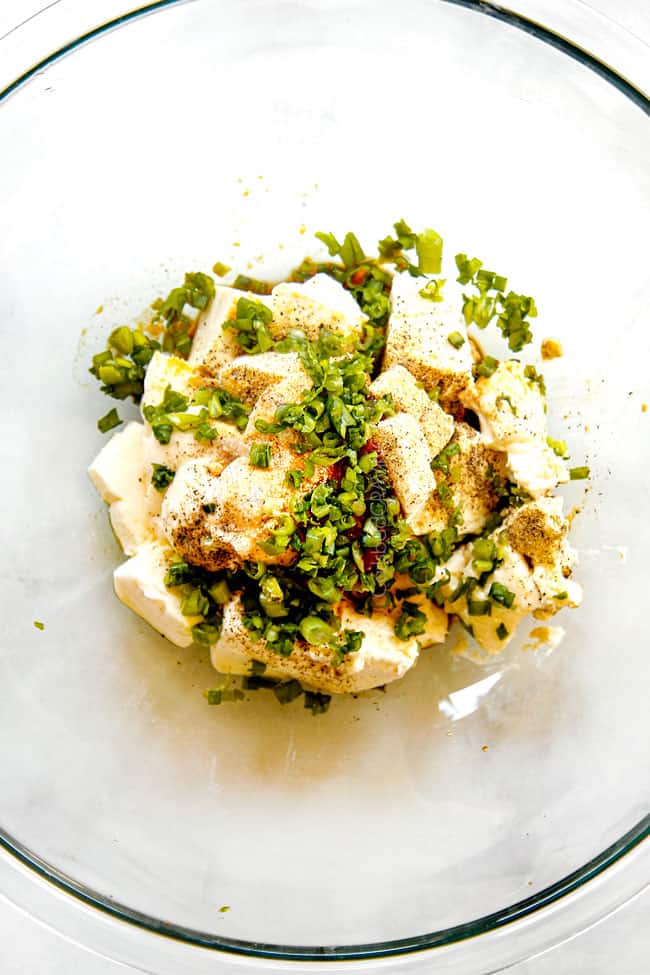


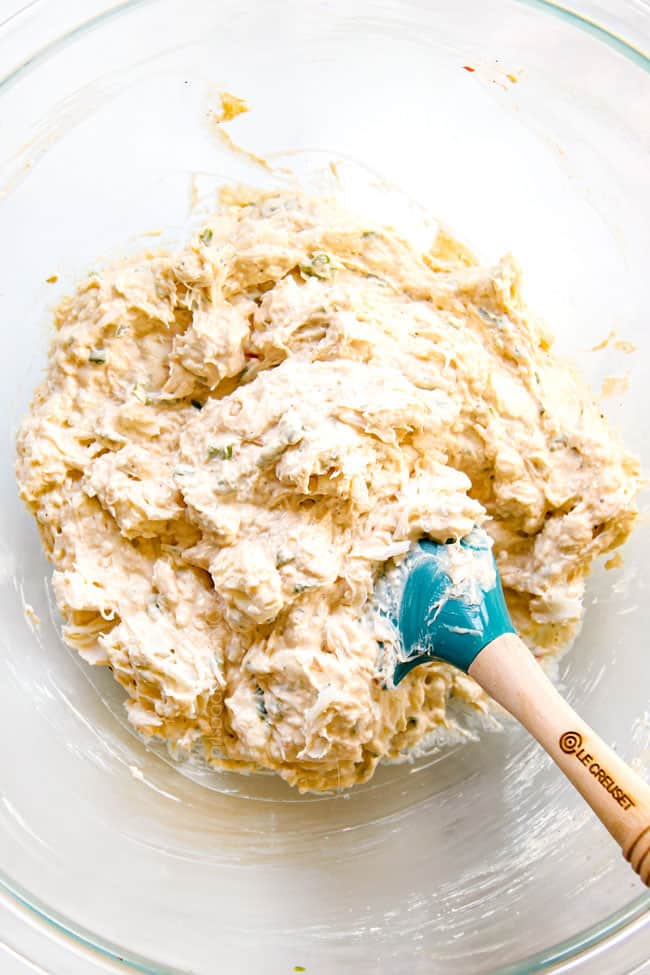

How to fold Crab Rangoon
Please don’t be intimidated by folding crab rangoon! You can go as simple as a single-fold triangle, or folding up all 4 corners to make a purse shape. There really is no right or wrong way to shape your rangoon as long as 1) you press out any air around the filling and 2) make sure the edges are sealed together. Here is my easy method:
STEP 1: LAY OUT WRAPPERS
Working on a flat, dry surface, lay out 2-4 wonton wrappers. Keep remaining wontons covered with plastic wrap or in a large freezer bag. You can work with more or less wontons at a time depending on your comfort, speed and skill level. The key is to not let the wrappers dry out by sitting out too long while you’re working on other wontons.
STEP 2: ADD FILLING
This crab rangoon recipe uses classic square wonton wrappers which measure 3 ½ x 3 ½-inches. I find this size comfortable fits 1 tablespoon of filling placed in the center of the wonton. I prefer 1 tablespoon filling for the ideal creamy to crunchy ratio but if you can’t easily seal the wrappers, then you may reduce the filling to 2 teaspoons.
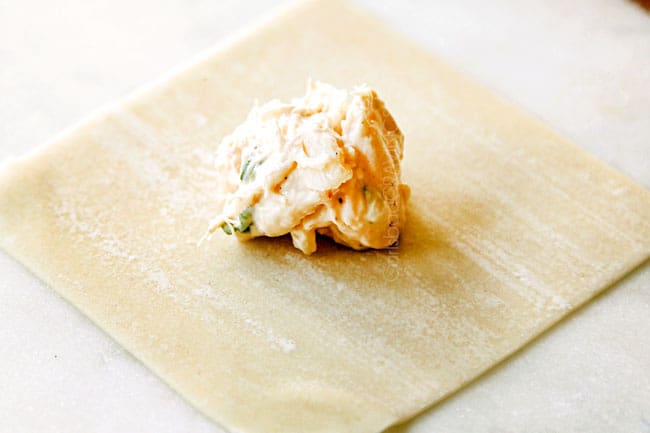
STEP 3: FOLD WRAPPERS
OPTION 1: TRIANGLE
- Working with one wonton at a time, brush the top 2 sides of wonton with cornstarch slurry with your finger.
- Next, bring the two opposite corners of the wonton together (2 dry, 2 wet) to form a triangle and enclose the filling, pinching edges of the wrapper together to firmly a seal, pressing out any excess air.
- Place finished wontons on parchment paper.
- Assemble remaining wontons in the same manner.
OPTION 2: “POUCH”
- Working with one wonton at a time, lightly brush all four corners with cornstarch slurry.
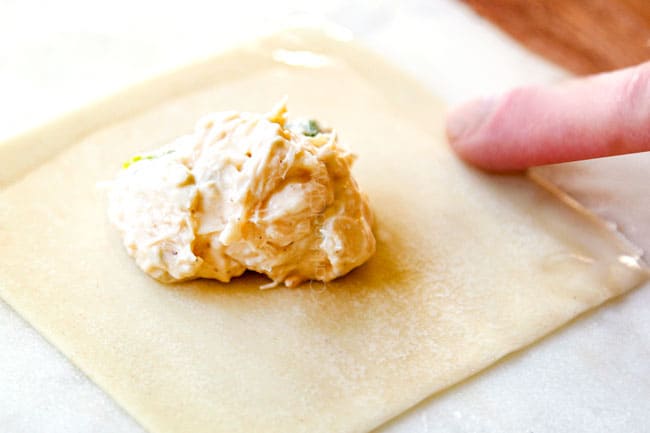
- Bring 2 opposite corners of the wonton together and pinch to seal.
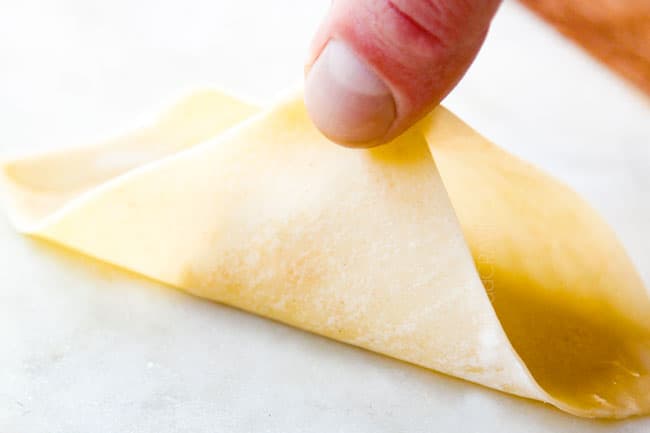
- Next, pull the other two corners up so all the tips are touching, pressing out any excess air.
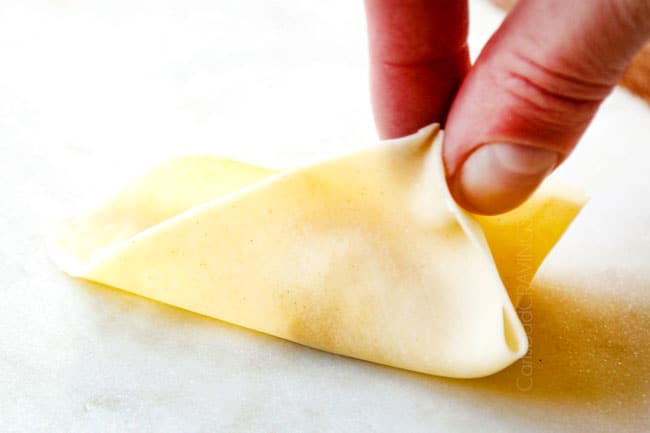
- Press the tops together to seal, then work your way down to tightly seal the edges. It is okay if the edges don’t evenly meet, as long as they are sealed closed.



Crab Rangoon Filling Tips
There are a couple tricks to ensure perfect homemade crab rangoon and prevent the wrappers from tearing:

SHOULD I BAKE OR FRY Homemade Crab Rangoon?
Just like I mentioned in my recent homemade egg roll post, I don’t fry much at my house because I think almost everything tastes just as good or almost as good baked BUT there are a few exceptions such as egg rolls and homemade crab rangoon. If you want the same tantalizing, shatteringly crunch you get from restaurant crab rangoon, then yes, you should fry them. No other cooking method will deliver the same satisfying crunch, the same puffed pillowy wonton wrapper or the same uniformly golden crackling exterior.
That being said, you still can bake the crab rangoon or cook them in the air fryer (instructions to follow) but don’t expect the same golden appearance or all-over crunchy exterior.

What oil is best for frying crab wontons?
Our goal of deep frying the crab rangoon is to create a deeply golden, crunchy exterior. To do this, you need an oil with a high smoking point (around 450°F/232°C) and neutral flavor. If you select an oil with a low smoking point, not only will you have an incredible amount of smoke, but the oil will break down creating an unpleasant odor and unappetizing taste.
Vegetable oil is my go-to oil for frying because it has a smoking point comfortably above frying temperature and is very neutral. Other oils suitable for frying (although some aren’t as neutral as others) include:
• Peanut oil
• Soybean oil
• Safflower oil
• Canola oil
• Cottonseed oil
• Corn oil
• Sunflower oil

How to fry Crab Rangoons
Let’s take a closer look at how to make this recipe with step-by-step photos (full recipe in the printable recipe card at the bottom of the post):
1. Heat vegetable oil in a deep stock pot/Dutch oven or deep-fat fryer to 350 degrees F or medium high heat.
2. Gently add wontons in batches so they don’t overcrowd the pot.
3. Fry until golden brown, either pressing down with a metal spyder to submerge or turning over once to cook evenly.
4. Drain on paper towels and repeat with remaining crab rangoons.
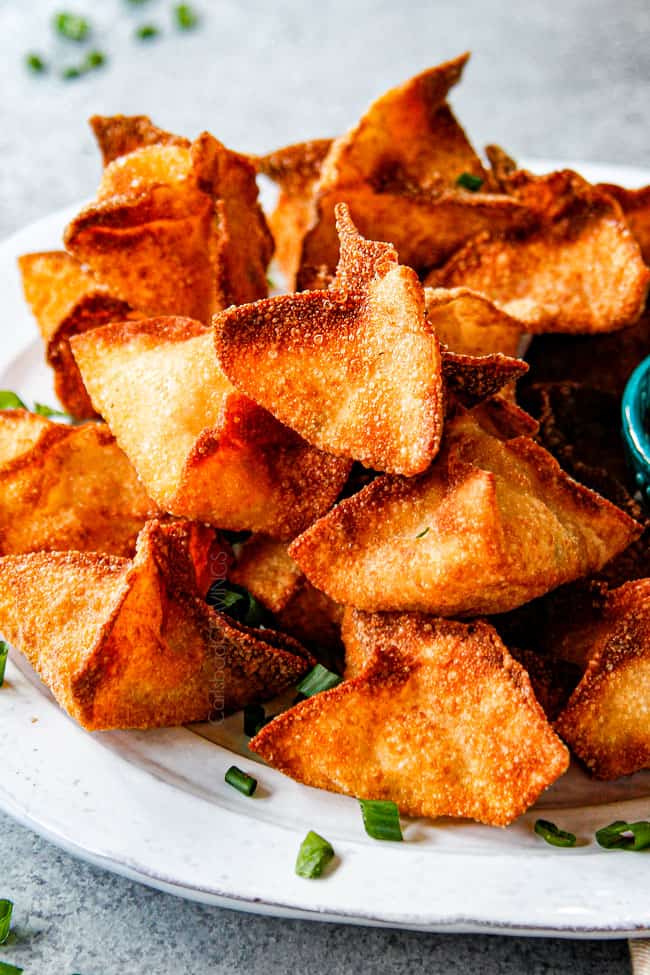

Homemade Crab Rangoon Frying Tips
If you aren’t familiar with frying, it is easy! Here are some helpful tips and tricks for the perfect fried crab rangoon every time:

How to Bake Crab Rangoons
While crab rangoon are traditionally deep fried, you can also bake them. If baking, I suggest folding the wonton wrappers into a triangle because the flat surface crisps up better in the oven. Baked crab rangoon won’t get as crunchy all over as fried, but it is a good option to save on a few calories.
To bake:
1. Preheat oven to 400 degrees F.
2. Place a baking rack on top of baking sheet and spray with cooking spray.
3. Place the sheet in the oven for 5 minutes. This will help crisp up the bottom of the wontons.
4. Carefully line rangoon on the greased baking rack so they aren’t touching.
5. Spray rangoons with cooking spray or lightly brush with coconut or olive oil.
6. Bake at 400 degrees F for 8-12 minutes or until corners are browned and crispy.
How to Air Fry Crab Rangoons
If you want to save a few calories, you can try the air fryer, but I prefer the oven over the air fryer for this recipe. Please note air fried crab rangoon will not become puffy or blister uniformly like fried rangoon.
To make Rangoon in the air fryer:
1. Spray the air fryer basket with nonstick spray.
2. Place crab rangoon in a single layer in the basket without touching, don’t overcrowd.
3. For best results, brush generously with oil on both sides. You can also lightly spray them, but they won’t taste fried.
4. Air fry at 350°F for 8-10 minutes or until golden. You can air fry without flipping them over, but for best results, flip halfway through cooking with tongs. Please note Air fryer models can vary in so watch the first batch closely and adjust the time accordingly.

How to Store Homemade Crab Rangoon
Cooked crab rangoon should be transferred to an airtight container and stored in the refrigerator. When properly stored, crab rangoon will last about 4 days.

HOW TO REHEAT CRAB RANGOON
Homemade crab rangoon are best eaten hot when the wrappers are the crunchiest, BUT you can reheat leftover rangoon:
OVEN: line them in a single layer on a baking sheet and bake at 300 degrees F for 5-10 minutes until heated through.
AIR FRYER: place rangoons in a single layer and reheat a per instructions per your air fryer model.

Can crab rangoon be made ahead of time?
Crab rangoon can be assembled and frozen ahead of time but they cannot be refrigerated uncooked. Wonton wrappers dry out very quickly and will become brittle when refrigerated if they have not been cooked, which will cause them to tear and leak when baked or fried. It is better to freeze uncooked crab wontons instead of refrigerating them (see section below).
You can, however, mix all of the filling ingredients together, cover with plastic wrap and refrigerate for up to 24 hours.
Can You Freeze Crab Rangoon?
Yes, you can freeze crab rangoon before or after you cook them, but I recommend freezing before cooking. Freezing is a wonderful option if:
• you have leftover crab wontons
• you want an easy dinner for later
• you want to eat one rangoon at a time for a snack
• you want an easy appetizer that you just pull out and cook
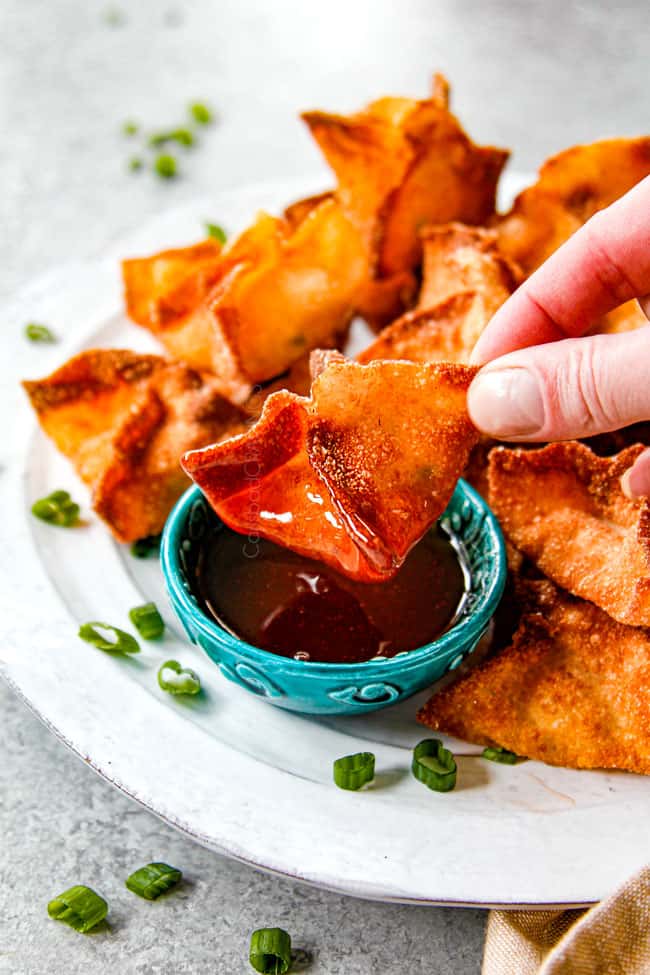

HOW TO FREEZE UNCOOKED CRAB RANGOON:
Instead of refrigerating uncooked crab rangoon which will dry them out, you can freeze them instead! To freeze:
• Place assembled, uncooked crab wontons on a parchment-lined baking sheet/plate (whatever will fit in your freezer) without touching.
• Loosely cover with plastic wrap.
• Freeze until solid, about 1 hour.
• Transfer wontons to a freezer bag.
• To cook, let crab rangoon sit at room temperature for 10 minutes then either fry, air fry or bake (they will still be partially frozen), according to recipe directions, adding a few extra minutes to cooking time.
HOW TO FREEZE COOKED CRAB RANGOON:
Freezing the cooked crab rangoon creates a fabulous easy- snack/appetizer option for all those busy parties or nights. To freeze:
• Cook crab wontons according to recipe directions.
• Let them cool COMPLETELY.
• Place assembled crab rangoon on a parchment-lined baking sheet/plate (whatever will fit in your freezer) without touching.
• Loosely cover with plastic wrap.
• Freeze wontons until solid, about 1 hour. Flash freezing them allows them to be stored together without sticking to each other.
• Transfer wontons to a freezer bag and squeeze out any excess air.
• When ready to serve, either re-fry rangoons straight out of the freezer (don’t defrost), OR bake from frozen per instructions, adding about 5 minutes to baking time.

What goes good with crab rangoon?
My favorite dip for homemade crab rangoon is sweet and sour sauce. The sweet tanginess cuts through the creaminess and enhances the flavor of the crab filling. You may also serve crab wontons with Asian sweet chili sauce, duck sauce, plum sauce, or hot mustard.
This sweet and sour sauce is beautifully simple to make. Simply combine the ingredients and simmer – that’s it! Afterwards, give it a taste and feel free to customize it so it’s YOUR favorite sweet and sour sauce. Add more sugar for sweeter, more vinegar for more tang and chili sauce for a kick.
For this sweet and sour sauce, you will need:
• pineapple juice: I purchase a pack of small cans – they are perfect for something like this. You can transfer the remaining pineapple juice to a plastic bag and freeze for later.
• red wine vinegar: has a distinct flavor and is best not to swap out for another vinegar in this scenario.
• sugar: granulated sugar is best here, use more or less to taste.
• ketchup: is non-negotiable.
• soy sauce: use reduced sodium like we do in the filling.
• seasonings: a pinch of salt and ginger powder enhance the flavors.
• Asian chili sauce: such as Sambal Oelek adds flavor but will not make your dipping sauce spicy. Of course, you can always add more or less to taste.

HOW DO I THIN DIPPING SAUCE?
Your sweet and sour sauce will continue to thicken as it sits, so don’t thicken it on the stove to the exact consistency you want it, but leave a little wiggle room for it to thicken slightly. If it simmers to the point of too thick or sits and becomes too thick, don’t worry! It is easy to thin by whisking in some water over low heat. Alternatively, if your sweet and sour sauce is too runny, then return to a simmer to thicken.

HOW DO I STORE DIPPING SAUCE?
Sweet and sour sauce can be made ahead of time and stored in an airtight container for up to two weeks. When ready to use, just reheat over low heat with a couple tablespoons water, not to make it warm but too thin as it will thick upon refrigeration.

What to serve with Crab Rangoons
This crab rangoon recipe is a must-have appetizer. They pair with practically all of my Asian inspired dishes, and I have a TON – or you can serve them with other appetizers. Here are just a few ideas to jump start your imagination:
FAQs
Much like General’s Tso’s Chicken and Orange Chicken, Crab Rangoon is not authentic to Chinese cuisine because it contains cream cheese that is not traditionally used in Chinese food. Still, it has been adopted by many American Chinese and Thai restaurants – much to all of our pleasure.
The exact origin of crab rangoon is unclear, but we do know the wrapper/wonton originated in the Canton region of china. The word “wonton” is Cantonese for “swallowing clouds.” The addition of cream cheese to the wonton wrapper is believed to originate in Burma but was not popularized because dairy was not widely available in that area of Asia at the time.
It wasn’t until a Polynesian restaurant in San Francisco, named Trader Vic’s, began serving crab rangoons in 1956 that the world learned of the satisfying combination. So, we have China, Burma and the United States to thank for the evolution of “swallowing clouds” of delightful crab rangoon.
There actually is not a difference between wontons and rangoons. Whether you’ve ordered crab rangoons or crab wontons at your favorite restaurant – they are identical, just with a different name. I just call them delicious.
Rangoon is actually a Burmese city. Wontons filled with cream cheese and imitation crab are named after the city – crab rangoons, whereas wontons just filled with cream cheese are often referred to as wontons – but they are used interchangeably.
Wontons when not referred to as “cream cheese wontons” refer to dumplings like in my Wonton
Soup. They use the same wrapper but have a savory, meaty filling. So now you have multiple reasons to buy wonton wrappers!

Want to try this Crab Rangoon RECIPE?
PIN IT to your recipe BOARD TO SAVE FOR LATER!
FIND ME ON PINTEREST FOR MORE GREAT RECIPES! I AM ALWAYS PINNING :)!
©Carlsbad Cravings by CarlsbadCravings.com
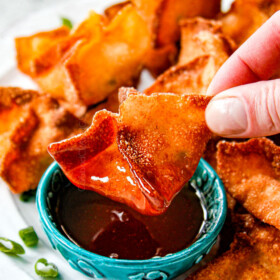
Crab Rangoons
Save This Recipe To Your Recipe Box
You can now create an account on our site and save your favorite recipes all in one place!
Ingredients
- 36 wonton wrappers
- 3 tablespoons water mixed with 2 teaspoons cornstarch
Filling
- 6 oz. lump crabmeat canned or fresh picked over, patted dry*
- 12 oz. cream cheese softened
- 3 tablespoons mayonnaise
- 1/4 cup finely chopped green onions
- 1 teaspoon reduced sodium soy sauce
- 1 teaspoon Worcestershire sauce
- 1 teaspoon Asian chili sauce
- 1/2 teaspoon toasted sesame oil
- 1/2 teaspoon lemon juice
- 1/2 teaspoon sugar
- 1/2 teaspoon garlic powder
- 1/4 tsp EACH dried mustard, salt, pepper
Sweet and Sour Sauce
- 3/4 cups sugar
- 1/2 cup red wine vinegar
- 1/4 cup pineapple juice
- 3 tablespoons ketchup
- 1 tablespoon soy sauce
- 2 teaspoons cornstarch
- 1/2 teaspoon Asian chili sauce
- 1/2 teaspoon salt
- 1/4 teaspoon ginger powder
Instructions
SWEET AND SOUR SAUCE
- Whisk together all Sweet and Sour Sauce ingredients in a medium saucepan. Bring to a boil then reduce to a simmer until slightly thickened. Set aside. (Sauce will continue to thicken as it cools.)
TO MAKE RANGOONS
- Mix together all of the filling ingredients except the crab meat, then gently fold crab into cream cheese mixture.
- Line a baking sheet with parchment paper (to lay assembled wontons on).
- Working on a flat, dry surface, lay out 2-4 wonton wrappers. Keep remaining wontons covered with plastic wrap or in a large freezer bag. Place one scant tablespoon wonton filling in the center of each wonton wrapper.
- TO FOLD ALL FOUR CORNERS: Working with one wonton wrapper at a time, lightly brush the 4 edges of the wrapper with the water/cornstarch mixture. Bring the two opposite corners of the wonton together and pinch to seal. Next, pull the other two corners up so all the tips are touching. Press the tips together to seal, then work your way down to tightly seal the edges, pressing out excess air. It is okay if the edges don’t evenly meet, as long as they are sealed closed. Place finished wontons on prepared surface and cover with a clean damp towel. Repeat with remaining wontons.
- TO FOLD INTO TRIANGLES (recommended if baking): Working with one wonton wrapper at a time, brush the top 2 sides of the wrapper with water. Bring the two opposite corners of the wonton together (2 dry, 2 wet) to form a triangle and enclose the filling, pinching edges of the wrapper together to firmly seal, pressing out any air. Place finished wontons on prepared surface and cover with a clean damp towel. Repeat with remaining wontons.
- Fill Dutch oven with 4 inches of vegetable oil and heat to 350 degrees (medium-high). If you don't have a thermometer, make sure to test a spare wonton to ensure the oil isn't too hot.
- Gently add rangoons in batches so they don’t overcrowd the pot, about 4-6. Fry until golden brown, either pressing down with a metal spyder to submerge or turning over once to cook evenly. Drain on paper towels and repeat with remaining rangoons.
Notes
*CRAB MEAT
You have three options for crab meat in your crab rangoon recipe: canned crab, fresh crab or imitation crab. See post for full breakdown. This crab rangoon recipe combines crab with the cream cheese for a creamy filling, so I don’t think there’s a need to splurge on fresh crab. I personally prefer using canned crab because it is more economical, easy to use because it’s already been picked through, easy to keep in the pantry and the flavor and texture are ideal for the filling. When purchasing canned crab meat, you will need one 6 oz. can white lump crab meat, which comes from the knuckles of the crab and is the highest grade of canned crab meat. You may also use fancy white crab meat, which contains the white body meat, but it is considered one step down.TIPS FOR MAKING CRAB RANGOON
There are a couple tricks to ensure perfect homemade crab rangoon and prevent the wrappers from tearing:- Cover wrappers. Wonton wrappers can easily dry out which will make them brittle and break or tear easily either while filling or while frying. To prevent this, keep any wrappers you are not working with under a damp cloth or in a sealed bag. Only remove them when you are ready to use them.
- Remove excess moisture. You don’t want any excess moisture from your crab because soggy filling will make soggy crab rangoon that can easily tear. Make sure your crab is very dry before adding to the filling.
- Don’t over stuff. If you are having trouble sealing the wonton around the filling, then reduce the amount of filling.
- Remove excess air. Make sure you push out any excess air as you fold the wonton to prevent the filling from leaking into the oil or the oil leaking into the rangoon and causing it to crack.
- Seal tightly. It is important that the crab rangoon are completely sealed otherwise the filling can leak out while frying and cause dangerous splattering. If you find your wrappers aren’t sealing, it might be because the edges are too wet – don’t use too much slurry to seal.
- Use parchment. Placing the stuffed crab rangoon on parchment paper is important so they don’t stick, otherwise, they can stick to a cutting board/other surface and tear.
- Limit water. Don’t use too much water/cornstarch slurry to seal the wrappers otherwise the wontons become soggy and the edges will not stick together. Only lightly dampen the edges.
- Clean work surface. Before you start a new batch of wontons, wipe your working surface so it is dry otherwise your wrappers will become soggy and tear.
- Cover after assembling. Just like you need to cover the wrappers before using, you need to keep the assembled crab wontons covered. If the wrappers dry out, they will easily crack when placed in the hot oil. As soon as you have folded your crab rangoon, place them on parchment paper and cover with a damp cloth.
Do I have to fry CRAB RANGOON?
If you want the same tantalizing, shatteringly crunch you get from restaurant crab rangoon, then yes, you should fry them. No other cooking method will deliver the same satisfying crunch, the same puffed pillowy wonton wrapper or the same uniformly golden crackling exterior. That being said, you still can bake the crab rangoon or cook them in the air fryer (instructions to follow) but don’t expect the same golden appearance or all-over crunchy exterior.PRO TIPS FOR FRYING CRAB RANGOON
If you aren’t familiar with frying, it is easy! Here are some helpful tips and tricks for the perfect fried crab rangoon every time:- Use enough oil. Use enough oil so the crab rangoon can sit comfortably in the oil without touching the bottom of the pan.
- Use an instant read thermometer. I highly recommend an instant-read thermometer to ensure you have the correct temperature not only at the beginning of frying, but throughout the entire frying process. It will save you a few “test wontons” or wrappers. If your oil is too hot, then the wontons will brown quickly, but won’t be as crispy because there wasn’t enough time for the water to evaporate. If the oil is too cold, the wontons will never reach peak crispiness. You can still fry without a thermometer, but it may be more trial and error.
- Test oil. If you don’t have a thermometer, medium-high heat should be about right, but every stove is different, so you will want to test the oil before frying the wontons. Test the temperature with a pinch of flour or better yet, an extra wonton wrapper. If it boils, your oil is ready but if it boils and turns dark within a minute or so, your oil is too hot. You will have to remove from the heat, wait a few minutes, return to heat and try again.
- Don’t overcrowd pan. Be patient and cook just 4-6 crab rangoon at a time depending on your pan size. This allows them to cook evenly without touching and gives you plenty of room to flip the wontons over with tongs. This also helps you keep a close eye on them so they don’t overcook.
- Adjust heat. If you find your crab wontons are cooking too quickly and surpassing the golden brown, then lower heat.
- Don’t overcook. We are not worried about cooking any raw filling, so it is best to remove the homemade crab rangoon when you think they could become a little more golden because they will deepen a few shades when removed from the oil. Keep a close eye on the wontons because they cook extremely quickly!
- Cook evenly. To fry crab rangoon evenly, you can flip them over while cooking to submerge the tops or the easiest, more effective way, is to push them down with ametal spyder so they are completely submerged in oil.
- Line on paper towels. Use a stainless-steel strainer or slotted spoon to transfer fried crab rangoon to a paper towel lined baking sheet or serving platter in a single layer without touching. You don’t want them touching or they will steam and you don’t want them sitting in oil or they won’t be as crispy. If you don’t have a strainer, then you can use tongs but be careful not to puncture or drop them!
- Don’t stack. Resist the urge to stack the cooked crab wontons or they won’t be as crispy. I know I didn’t follow my own advice in the photos so I can speak from personal experience that stacked wontons will steam and you will lose that shatteringly crispy coveted exterior. It is best to serve the homemade crab rangoon lined in a single layer with a little breathing room in between each one.
- Wait before eating. Wait 5 to 10 minutes before serving or biting into the crab wontons because the filling will be piping hot and can easily burn your mouth.
TO BAKE:
- Preheat oven to 400 degrees F.
- Place a baking rack on top of baking sheet and spray with cooking spray.
- Place the sheet in the
oven for 5 minutes. This will help crisp
up the bottom of the rangoons. - Carefully line rangoons on the greased baking rack so they
aren’t touching. - Spray rangoons with cooking spray or lightly brush with coconut or olive
oil. - Bake at 400 degrees F for 8-12 minutes or until corners are browned and
crispy.
TO AIR FRY:
- Spray the air fryer basket with nonstick spray.
- Place crab rangoon in a single layer in the basket without
touching, don’t overcrowd. - For best results, brush generously with oil on both sides. You
can also lightly spray them, but they won’t taste fried. - Air fry at 350°F for 8-10
minutes or until golden. You can air
fry without flipping them over, but for best results, flip halfway through
cooking with tongs. Please note Air
fryer models can vary in so watch the first batch closely and adjust the time accordingly.
HOW TO REHEAT CRAB RANGOON
Homemade crab rangoon are best eaten hot when the wrappers are the crunchiest, BUT you can reheat leftover rangoon:- OVEN: line them in a single layer on a baking sheet and bake at 300 degrees F for 5-10 minutes until heated through.
- AIR FRYER: place rangoons in a single layer and reheat a per instructions per your air fryer model.
Can crab rangoon be made ahead of time?
Crab rangoon can be assembled and frozen ahead of time but they cannot be refrigerated uncooked. Wonton wrappers dry out very quickly and will become brittle when refrigerated if they have not been cooked, which will cause them to tear and leak when baked or fried. It is better to freeze uncooked crab wontons instead of refrigerating them (see section below).HOW TO FREEZE UNCOOKED CRAB RANGOON:
Instead of refrigerating uncooked crab rangoon which will dry them out, you can freeze them instead! Freezing uncooked crab rangoon is the best option if making ahead. To freeze:- Place assembled, uncooked crab wontons on a parchment-lined baking sheet/plate (whatever will fit in your freezer) without touching.
- Loosely cover with plastic wrap.
- Freeze until solid, about 1 hour.
- Transfer wontons to a freezer bag.
- To cook, let crab rangoon sit at room temperature for 10 minutes then either fry, air fry or bake (they will still be partially frozen), according to recipe directions, adding a few extra minutes to cooking time.
HOW TO FREEZE COOKED CRAB RANGOON:
Freezing the cooked crab rangoon creates a fabulous easy- snack/appetizer option for all those busy parties or nights. To freeze:- Cook crab wontons according to recipe directions.
- Let them cool COMPLETELY.
- Place assembled crab rangoon on a parchment-lined baking sheet/plate (whatever will fit in your freezer) without touching.
- Loosely cover with plastic wrap.
- Freeze wontons until solid, about 1 hour. Flash freezing them allows them to be stored together without sticking to each other.
- Transfer wontons to a freezer bag and squeeze out any excess air.
- When ready to serve, either re-fry rangoons straight out of the freezer (don’t defrost), OR bake from frozen per instructions, adding about 5 minutes to baking time.

Did You Make This Recipe?
Tag @CarlsbadCravings and Use #CarlsbadCravngs
Leave a Review, I Always Love Hearing From You!
Carlsbad Cravings© Original

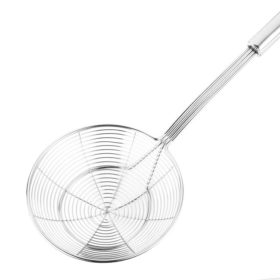
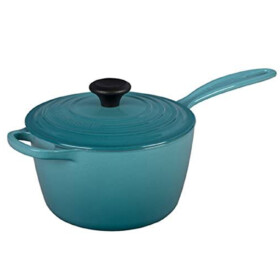

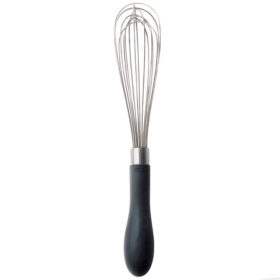
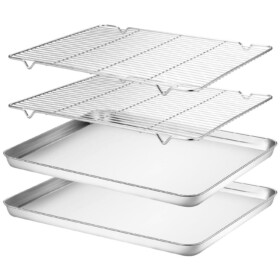

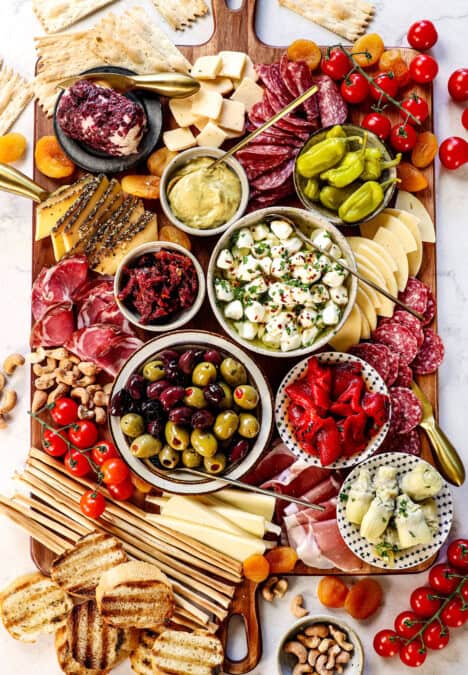



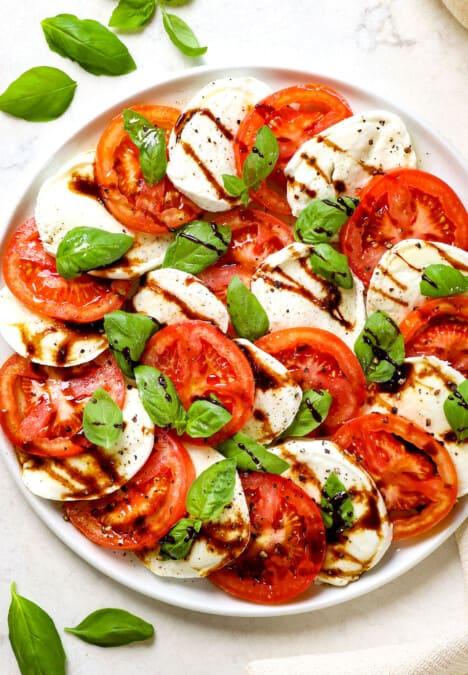























Pam Allison says
I really want to try frying these, but I’ve never fried anything. What do you do with the oil after you are done frying the rangoons? How do you dispose of it?
Jen says
Hi Pam, you are going to love the fried version! To dispose of the oil, let it cool completely then transfer to an empty disposable container with a sealable lid like an empty milk carton, then place it in the trash. Hope that helps!
deb hole says
I am taking these to a bridal shower at a bar. there is no way to reheat so how do I transport them without them getting soggy
Jen says
Unfortunately these are best served fresh.
Olga says
Can I leave out the mayo and mustard (not fans of those flavors)?
Jen says
Hi Olga, yes that should be just fine. I would replace the mayonnaise with sour cream or extra cream cheese. enjoy!
Olga says
I’ve made these twice now with rave reviews! The flavor is excellent and IMO far better than a restaurant. The only changes I made were omitting the mayo both times and the second time I reduced the cream cheese to 8 oz (just a matter of personal preference how crabby or cheesey you like it I think:). I totally agree that deep frying is the way to go here. I used the Mae Ploy sweet chili sauce for dipping (had bought that for your amazing yakitori that I have also now made multiple times) but do want to try your sweet and sour sauce. My quarantine buddies are already begging for more rangoon so it will be soon:)
Jen says
Thanks so much for your awesome review Olga, I’m honored these rangoons are “better than a restaurant!” Your quarantine buddies have lucked out with your cooking skills!
Monica says
I have been craving real crab rangoons and eyeing this recipe for a while. The techniques are spot on and I had no trouble wrapping the rangoons and frying them. The texture and filling to wrapper ratio was just right. I think I would have preferred the filling to be a tad bit sweeter and the sauce to be less sweet as the sauce was super sweet. I bought the lump crab meet described as the highest quality canned crab you can buy. This is the third time I have used canned crab in a recipe. Every time I thought it tasted kind of fishy or something. Maybe I just don’t like canned crab. It smelled fine when I opened it and looked high quality. I think next time I will actually use either fresh crab or imitation crab to get the texture and flavor I am looking for and missing. This is not the recipe’s fault only my personal preference. I love the recipes on this website!
Jen says
Thanks Monica, imitation or fresh crab would definitely take these to a whole new level!
Grace says
Absolutely loved this recipe …. I did use imitation crabmeat (thats all I had) and I cooked them in mini muffin tins sprayed with cooking spray(little stuffed cups) and then baked them at 325 for 12-13 mins I had to start checking them at 10 minutes because I could only find the vegan wontons and these things cook faster then the regular wontons…. However you decide to cook them it will be fantastic tasting!
Jen says
Thank you, Grace! I am so happy you enjoyed them! Thanks for commenting!